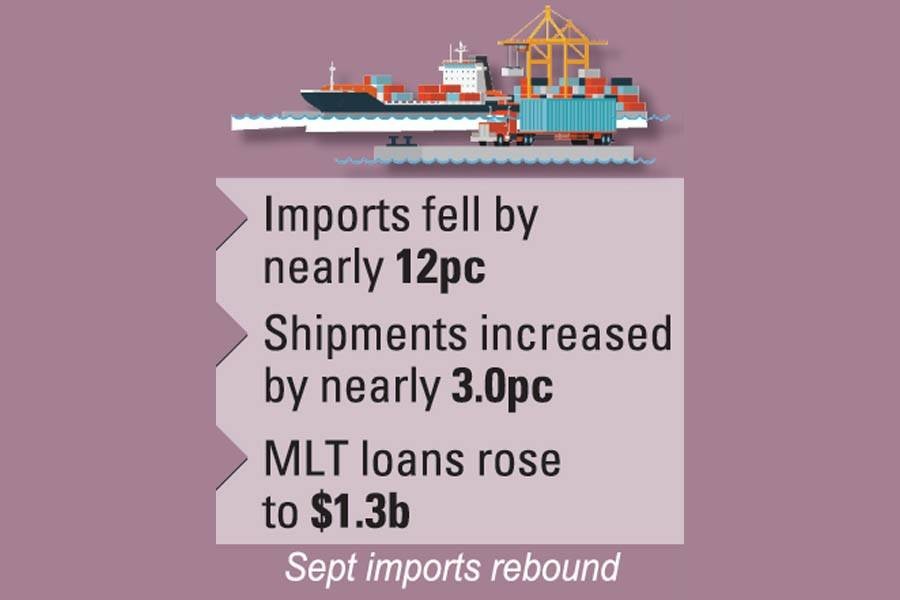The country's overall Balance of Payments (BoP) posted a surplus at over US$ 3.0 billion in the July-September period, according to the central bank of Bangladesh.
Many economists believe the slow pace of imports and higher remittance and external fund inflows were the reasons for the surplus.
The BoP was in deficit of over $200 million during the same period a year earlier, sources said.
The BoP summarises all transactions that a country's individuals, companies, and government bodies make with individuals, companies, and government bodies outside the country.
A BoP surplus means Bangladesh received much more than it spent for the overseas parties, leading to its liquidity buffer.
Dr. Ahsan H. Mansur, executive director at the Policy Research Institute of Bangladesh (PRI) said: "This is mainly because of slow import".
The imports fell by nearly 12 per cent in the period compared to the corresponding period a year back.
On the other hand, shipments increased by nearly 3.0 per cent in the period over the same period in 2019, meaning the net payment from trade surged during the period.
Dr. Mansur, who once had served at the IMF, said there were many other reasons like the workers' remittance inflow was much higher in the period.
The remittance inflow grew by nearly 49 per cent in the period to $6.7. billion.
The KSA has retained the top position in terms of remittance flows to Bangladesh with $1.6 billion followed by the USA with $815 million during the period.
Besides, he mentioned that Bangladesh received foreign borrowings from international lenders during the period under review.
The borrowings came from the Asian Development Bank, the World Bank and the International Monetary Fund (IMF) to prop up the COVID-19-affected economy.
The receipts in the form of MLT loans (medium and long term loans) were recorded at $1.3 billion, up by nearly 54 per cent in Q1 of the fiscal year 2021.
According to the central bank, the BoP position reflects a record high final gross international reserve or foreign exchange reserve level of $ 40 billion-plus in this October.
At this level, Bangladesh Bank has an ample external liquidity buffer, which can cushion the domestic economy against external shocks.
Meanwhile, Bangladesh's overall imports rebounded in September after maintaining a falling trend in two consecutive months indicating a gradual revamp of the economic activities, officials said.
"It's a good sign for our economy," a senior official of the Bangladesh Bank (BB) told the FE while explaining the rising trend in imports.
Higher imports indicate that the country's economy is returning to normalcy, the central banker added.
Opening of letters of credit (LCs), generally known as import orders, jumped by nearly 54 per cent to $4.43 billion in September 2020 from $2.88 billion a month ago, according to the central bank's latest data.
On the other hand, the settlement of LCs, generally known as actual import, in terms of value, rose by more than 18 per cent to $3.71 billion in September from $3.13 billion in the previous month.
Bangladesh's overall economic activities are getting momentum gradually despite the ongoing pandemic, according to bankers and businessmen.
They believe that the upward trend in import may continue in the coming months to meet the possible higher demand for essential commodities in the domestic market.
Besides, higher prices of major commodities in the global market in recent months may push up import payment obligations in near future, they explained.
After analyzing the data for the last seven months, it was found that the falling trend in imports started in April this year following the spread of coronavirus in different parts of Bangladesh.
Imports increased in June just after reopening of the overall business activities across the country but the declining trend in imports started again from July 2020.
Talking to the FE, Md Abdul Halim Chowdhury, managing director and chief executive officer of Pubali Bank Limited, said the country's business activities have almost returned to normalcy.
The senior banker has expressed fears that Bangladesh's foreign trade covering both export and import might be hampered if the rising trend in coronavirus infections continues in the United States and the European Union (EU)'s member countries.
Actual import through back-to-back LCs of ready-made garment (RMG) products increased by nearly 26 per cent to $505.71 million in the month of September from $401.73 million a month before, the BB data showed.
Besides, imports of raw cotton grew by 30.37 per cent to $193.87 million in September last from $148.03 million in the previous month.
"The existing upward trend in imports may continue until December this calendar year as per export orders, placed by the buyers particularly from the EU and the USA," Sayeed Ahmad Chowdhury, general manager of Square Denims, predicted while explaining the latest situation in the apparel and clothing sector.
On the other hand, wheat imports through both public and private sectors rose to $207.28 million in September from $69.73 million in August 2020 while imports of pharmaceutical raw materials stood at $103.20 million from $91.62 million.
Imports of capital machinery came down to $221.48 million in September from $350.29 million a month ago, according to the central bank statistics.


